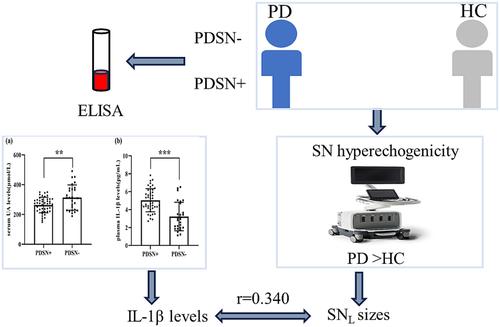当前位置:
X-MOL 学术
›
Eur. J. Nerosci.
›
论文详情
Our official English website, www.x-mol.net, welcomes your feedback! (Note: you will need to create a separate account there.)
Clinical findings of hyperechoic substantia nigra in patients with Parkinson's disease
European Journal of Neroscience ( IF 3.4 ) Pub Date : 2024-03-12 , DOI: 10.1111/ejn.16308 Yongyan Fan 1, 2 , Jianjun Ma 1, 2, 3 , Dawei Yang 1, 2 , Xiaohuan Li 1, 2 , Keke Liang 2, 3 , Zonghan She 1, 2 , Xuelin Qi 1, 2 , Xiaoxue Shi 1, 2, 3 , Qi Gu 1, 2, 3 , Jinhua Zheng 1, 2, 3 , Dongsheng Li 1, 2, 3
European Journal of Neroscience ( IF 3.4 ) Pub Date : 2024-03-12 , DOI: 10.1111/ejn.16308 Yongyan Fan 1, 2 , Jianjun Ma 1, 2, 3 , Dawei Yang 1, 2 , Xiaohuan Li 1, 2 , Keke Liang 2, 3 , Zonghan She 1, 2 , Xuelin Qi 1, 2 , Xiaoxue Shi 1, 2, 3 , Qi Gu 1, 2, 3 , Jinhua Zheng 1, 2, 3 , Dongsheng Li 1, 2, 3
Affiliation

|
This study aims to analyse hyperechoic substantia nigra (HSN) characteristics and the correlation of HSN with clinical features and blood biomarkers in patients with Parkinson's disease (PD). Transcranial sonography (TCS) evaluations of the substantia nigra (SN) were performed in 40 healthy controls and 71 patients with PD, including patients with SN hyperechogenicity (SN+) and those with normal SN echogenicity (SN−). Evaluation of motor and non‐motor symptoms was assessed by a series of rating scales. The uricase method was used to determine serum uric acid (UA) levels, and enzyme‐linked immunosorbent assay (ELISA) was used to measure plasma interleukin (IL)‐1β levels. TCS showed 92.50% specificity and 61.97% sensitivity in differentiating PD patients from controls. The area of SN+ contralateral to the side of initial motor symptoms (SNcontra ) was larger than that ipsilateral to the side of initial motor symptoms (SNipsi ). The PDSN+ group had lower Argentine Hyposmia Rating Scale (AHRS) scores and UA levels than the PDSN− group. Binary logistic regression analysis revealed that AHRS scores and UA levels could be independent predictors for HSN. The larger SN echogenic area (SNL ) sizes positively correlated with plasma IL‐1β levels in PD patients with SN+. The present study provides further evidence of the potential of SN echogenicity as an imaging biomarker for PD diagnosis. PD patients with HSN have more severe non‐motor symptoms of hyposmia. HSN in PD patients is related to the mechanism of abnormal iron metabolism and microglial activation.
中文翻译:

帕金森病患者黑质高回声的临床表现
本研究旨在分析帕金森病(PD)患者的高回声黑质(HSN)特征以及HSN与临床特征和血液生物标志物的相关性。对 40 名健康对照者和 71 名 PD 患者进行了黑质 (SN) 经颅超声 (TCS) 评估,其中包括 SN 高回声 (SN+) 和 SN 回声正常 (SN−) 的患者。通过一系列评定量表对运动和非运动症状进行评估。采用尿酸酶法测定血清尿酸(UA)水平,采用酶联免疫吸附试验(ELISA)测定血浆白细胞介素(IL)-1β水平。TCS 在区分 PD 患者和对照组方面显示出 92.50% 的特异性和 61.97% 的敏感性。初始运动症状一侧的 SN+ 区域(SN魂斗罗 )大于初始运动症状一侧的同侧(SN伊普西 )。PDSN+ 组的阿根廷低血压评定量表 (AHRS) 评分和 UA 水平低于 PDSN- 组。二元逻辑回归分析表明,AHRS 评分和 UA 水平可能是 HSN 的独立预测因子。较大的 SN 回声区(SNL ) SN+ 的 PD 患者的大小与血浆 IL-1β 水平呈正相关。本研究提供了 SN 回声作为 PD 诊断成像生物标志物潜力的进一步证据。患有 HSN 的 PD 患者有更严重的嗅觉减退非运动症状。PD患者的HSN与铁代谢异常和小胶质细胞活化的机制有关。
更新日期:2024-03-12
中文翻译:

帕金森病患者黑质高回声的临床表现
本研究旨在分析帕金森病(PD)患者的高回声黑质(HSN)特征以及HSN与临床特征和血液生物标志物的相关性。对 40 名健康对照者和 71 名 PD 患者进行了黑质 (SN) 经颅超声 (TCS) 评估,其中包括 SN 高回声 (SN+) 和 SN 回声正常 (SN−) 的患者。通过一系列评定量表对运动和非运动症状进行评估。采用尿酸酶法测定血清尿酸(UA)水平,采用酶联免疫吸附试验(ELISA)测定血浆白细胞介素(IL)-1β水平。TCS 在区分 PD 患者和对照组方面显示出 92.50% 的特异性和 61.97% 的敏感性。初始运动症状一侧的 SN+ 区域(SN



























 京公网安备 11010802027423号
京公网安备 11010802027423号